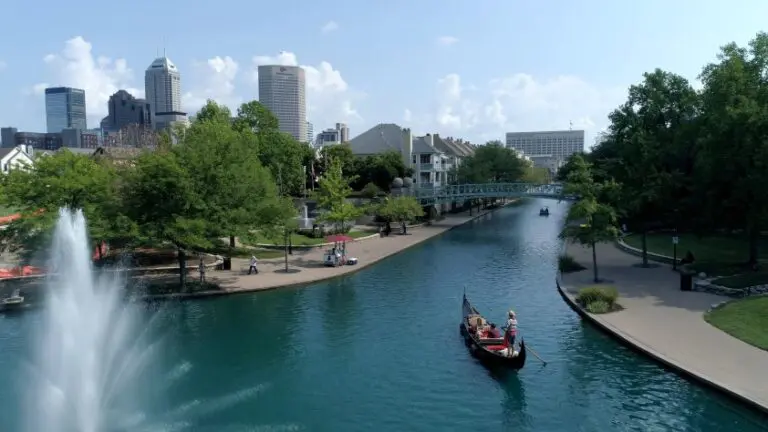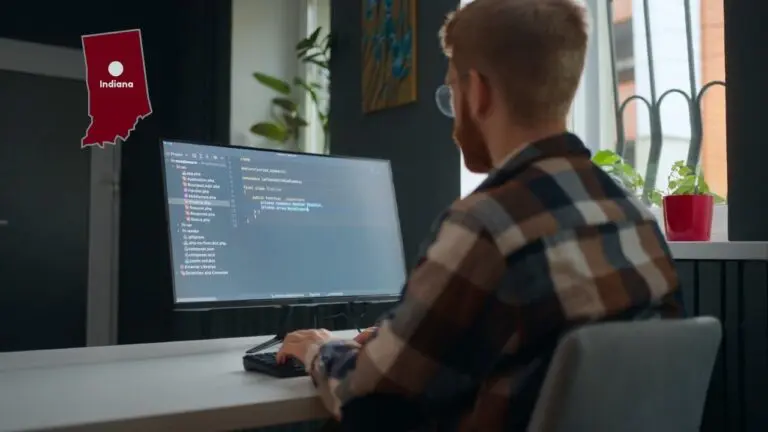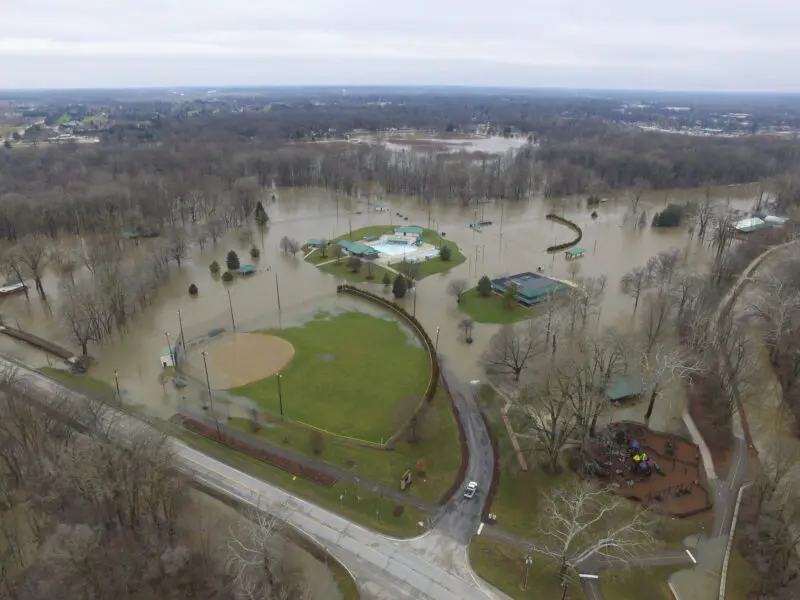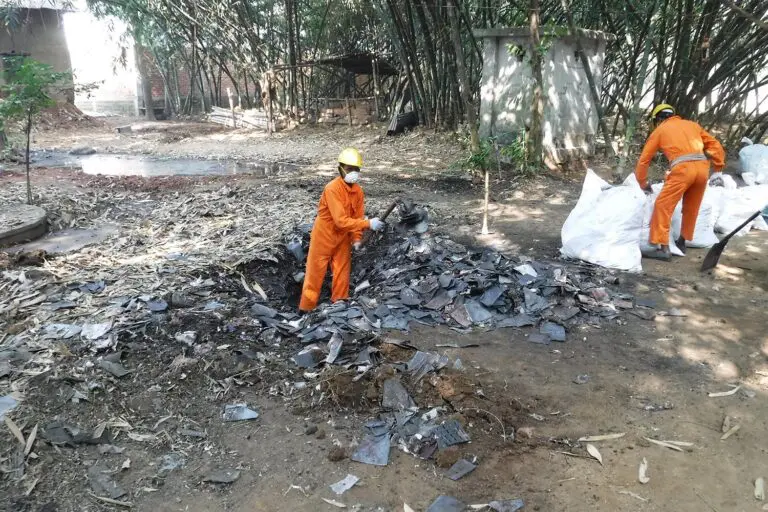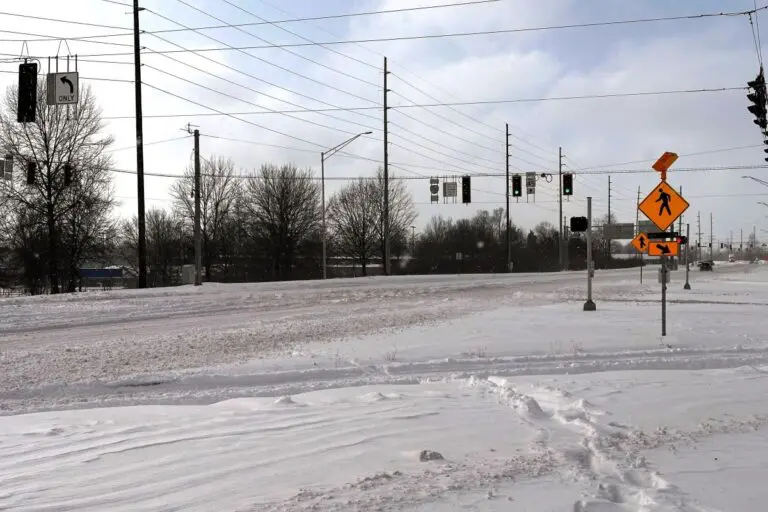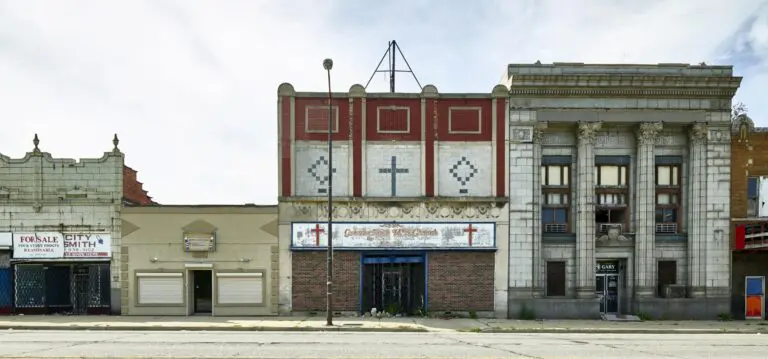November 11, 2019
Table of Contents
ToggleA Historic Town Faces Unprecedented Challenges
Nestled in the middle of Amish country near the Michigan border, Goshen, Indiana, revolves around its town square, where historic brick and stucco buildings sport bright coats of paint and interiors have been transformed into breweries, quirky shops and artists’ studios.
“Some say Goshen is the way America used to be,” says the town’s website. “We say it’s the way to an uncommonly robust future.”
But when historic flooding devastated the town of 32,000 in February 2018, the prospect of that robust future became less secure.
A combination of heavy rain and snow melt led the Elkhart River to rise to a record 13.2 feet. More than 300 structures were damaged, and citizens had to be evacuated by rescue teams.
A Mayor’s Resolve for Change
Faced with unprecedented challenges, the town responded on the fly. Its mayor, Jeremy Stutsman, vowed never to put the community in such a precarious position again.
“Having the experience of this past hailstorm where we saw streets flooding that had never ever flooded, the coldest ever winter last year — all of these to me are direct signs that we’re going to have to find ways to be more adaptable in the future,” Stutsman said.
Goshen lost three of its five river crossings in the first five hours of the flood. The water rose with such speed and volume, that evacuations were ordered for residents living in the affected area. It would take 97 hours before the water started to dissipate.
Stutsman spent 91 of those hours at city hall, along with five other town officials, facilitating communication among town departments and meeting residents’ needs as quickly as possible. In the aftermath of the flooding, officials saw the financial burden of flood disasters.
Erin Rowe, director of emergency response and recovery for the Indiana Department of Homeland Security, said more than 650 applicants in Elkhart County claimed more than $930,000 in emergency assistance. The experience showed town officials that Goshen would need to become more prepared for environmental change and the severe weather that comes with it.
Stutsman said the key to encouraging town-wide acceptance of the projects was focusing the discussions on the betterment of their community, rather than climate change as a whole.
“We didn’t argue about climate change,” he said. “We talked about Goshen. I showed them the numbers. I showed them what we could do. As a mayor, you need to make sure you’re giving the argument or allowing everybody to find the argument that allows them to support the initiatives you’re bringing forward. Staying out of the politically charged discussions is very important if you’re going to continue to get projects moving.”
“Our environment is something that once we lose, we will never get back,” Stutsman said. “There are so many facts we know about environmental projects that either save us money or help us to be healthier people. It’s what we need to be doing and how we need to be acting.”
A wet state gets wetter
Goshen’s plight isn’t unique in the Hoosier state. Historically, 24 percent of Indiana was covered by wetlands, and numerous waterways still cut across the state, making large swaths of land susceptible to severe flooding. And with climate change, Indiana is becoming wetter, with heavy rain events predicted to become more frequent in the coming years.
May 2018 to April 2019 was the wettest 12-month period on record in the state. This past spring, heavy rains delayed the planting of crops by many weeks, and residents who had never had to deal with flooding issues found knee-deep water on their streets.
These unprecedented levels of flooding have raised fears about Indiana’s disaster preparedness, both practically and economically. Concerns about how to recover from and prepare for natural disasters have plagued all levels of Indiana’s government.
Recently, the Federal Emergency Management Agency announced it is transferring the responsibility of first response to the states so it can focus on preparing for natural disasters before they happen. That shift in priorities will have a significant impact on Indiana, Rowe said.
“As the occurrences of more catastrophic events (Irma, Harvey, Katrina, Sandy) increase, FEMA will not have sufficient funding/resources to cover these massive events,” she said. “They will need to focus what resources they have on the areas with the most damage and need. This often excludes the more ‘everyday’ disasters. “
“While it is an understandable thought process, it will have a major impact on Indiana, as we don’t typically have the catastrophic disasters other states have experienced.”
Indiana is one of a few states with a disaster relief fund, which is financed by a percentage of firework sales throughout the state. But if firework sales are down, the fund suffers, meaning that individual citizens are faced with increased responsibility and cost following natural disasters.
Last spring, the fund had $2 million. Most homeowner policies do not cover flood damage, and only 1% of Indiana residents and businesses have flood insurance. Without it, the recovery costs from a major flood can be substantial. The Indiana Department of Natural Resources works with FEMA to map the river flood plains of the state.
But this doesn’t include urban flooding, even though urban flooding is covered under the national flood insurance program. And urban flooding is what has been growing the most, with inadequate sewers leading to flooding in homes and businesses, according to David Knipe, DNR Engineering Section Manager for the Central Basin.
“It is a hazard that is out there, and flood insurance is one tool to have to protect yourself from damages,” he said. “Pretty much anyone is allowed to purchase insurance through the national flood insurance program. You don’t have to be in the special flood hazard zone. You can be outside of that zone and still be at flood risk and still be protected.”
Disaster as a catalyst for change
Instead of ignoring any possible relation between heavy rain events and climate change, Goshen has used the flood disaster as a catalyst for prevention and economic growth. The town is now working with the Great Lakes Integrated Science and Assessment Group to better understand the movement of stormwater through the community and the causes of flooding.
“With the flooding we’ve been through over the last couple of years, this is going to be invaluable information to us,” Stutsman said. “We’re very hopeful it will not only help us in how we work with developers, projects in the city, but also help us to find those ways to start mitigating the flood issues from the start.”
Yet another project reaches out to the community’s younger residents. “My Goshen, Exploring My Natural Home,” teaches elementary school students about sense of place, stewardship, energy, and climate change.
“We believe that the more a student loves a place, the more they will want to take care of it,” said program developer Paul Steury.
As part of the program, students will visit the Mary Lee Environmental Learning Center of Goshen College for field experience and grade-appropriate activities. Once the program’s education packets are complete, they will be available free of charge on the City of Goshen website. The city has plans for several additional projects.
“For too long, economics have directed our discussion and lack of action when it comes to our environment,” said Stutsman. “We need to change this direction by showing the economic value and moving forward for green projects.”
However, he is conscious of the city’s budget and doesn’t want to over-spend or set up future mayors for failure.
“Doing an environmental project is great, but being able to afford it as mayor is essential,” he said. “You don’t want to spend so much money on green projects that your community can’t provide public safety or do snowplowing appropriately. We are always looking at financial aspects, but we have so much data, do so much research, and technology has come so far it’s becoming easier to do these projects.”
Laying the groundwork for change
Stutsman grew up in Goshen and went to Butler University in Indianapolis, graduating with a degree in biology. He didn’t think he would return to Goshen after graduation and never thought about public service, but he would become the town’s youngest mayor.
When he returned from Indianapolis, he began working in construction, remodeling and restoring some of the buildings along the downtown square. That led to a run for city council, which he served on for eight years, before turning his attention to becoming mayor.
When he entered office four years ago, he started laying the groundwork for Goshen’s environmental metamorphosis. Jeremy Stuntman speaking at Goshen College image by:Goshen College He began with small changes, such as having city employees use shared printers and changing to LED light bulbs in government offices.
As the smaller projects became popular and showed cost savings, the mayor, and his team began thinking of larger projects. One of Stutsman’s first initiatives was to put a youth adviser on the city council in the hopes of getting Goshen’s young people involved in the community.
Stutsman, a father of two, said this was important to him because having a teenage son taught him how thoughtful and insightful young people can be.
“I knew I wanted to develop the youth advisor position and help bring that youth voice closer to the community and closer to city government,” he said. “It has been absolutely phenomenal for our community to go through this.”
In fact, because of the success of the city council, several other non-profit boards in Goshen have appointed youth advisor positions as well. Goshen High School student Zoe Eichorn was elected by the student body and appointed to the council by the mayor for the 2019-20 school year.
Eichorn and fellow youth caucus members helped draft a resolution, passed in April, in which Goshen pledged to become carbon neutral by 2035. Students from all over Indiana meeting at the 2019 Earth Charter Leadership Summit in Goshen to discuss environmental issues and legislation for their communities.
Speaking before the 2019 Earth Charter Climate Leadership Summit, held at Goshen College in September, youth caucus member Simon Hertzler-Gascho emphasized the resolution’s importance for his generation.
“We as the youth are all much more connected, I think, to the environment than some of our older peers,” Hertzler-Gascho said. “I think the idea is that we are the ones that will be affected. So, as a caucus we decided this was important for us to work on. The resolution was mainly setting the ground work for the city council and especially the mayor to pass for their legislation in the months to come.”
The same resolution also included an initiative to grow the town’s tree canopy by 45%. Goshen currently has 13,500 public trees, which offer the community $1.5 million in ecological benefits, comprising energy savings, stormwater mitigation, carbon dioxide sequestration and mitigation, and benefits to private property.
“We are working hard to increase all these values by increasing our tree canopy,” Stutsman said.
In September, the council passed an ordinance proposed by the youth caucus to create a Department of Environmental Resiliency. In the past year, Goshen has also completed 92 solar projects, producing 116 watts per person.
That means the town outranks communities like Phoenix, Sacramento, Los Angeles, San Francisco, and Denver in amount of solar power per capita Stutsman said his environmental projects initially were met with a mixture of excitement and skepticism, but people slowly started to get on board.
“I don’t want to say a battle, but it’s been a lot of meetings, sitting down with people to get them on board for the resolution and the ordinance for creating a department of environmental resilience,” he said. “I showed them what we can do, what we know we can do, with more time to put into that process. That convinced them that we’re going to learn, with these types of projects will help us.”
Stutsman also spoke in September at the 2019 Earth Charter Climate Leadership Summit. He urged the audience to buy into the necessity of climate-change awareness in Indiana. In September, Stutsman took his message to the 2019 Earth Charter Climate Leadership Summit, held at Goshen College. He urged the audience to buy into the necessity of climate-change awareness in Indiana.
“Question: What do you do if the end of the world comes?” he joked. “Answer: Move to Indiana because everything happens 50 years later there.”
“We’re at a point where we can’t wait 50 years,” he told participants. “We must work on becoming a more environmentally resilient state and country. We need to become a state that leads, not follows.”
Update in 2024:



